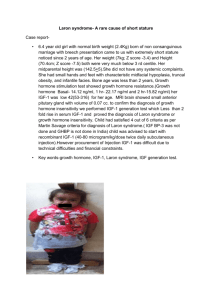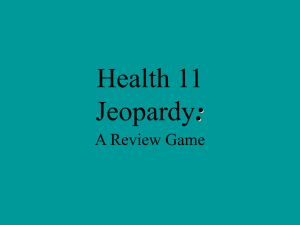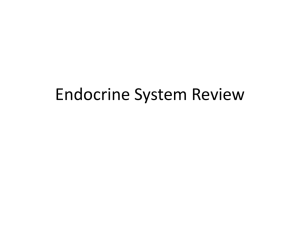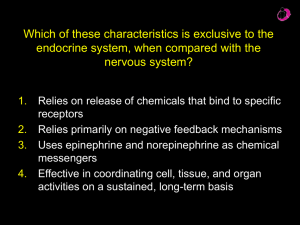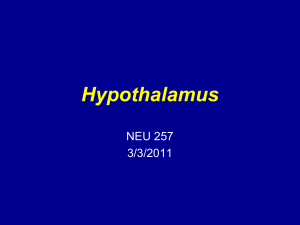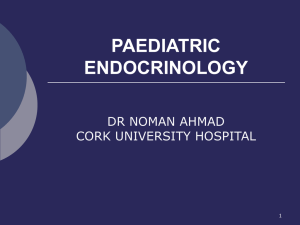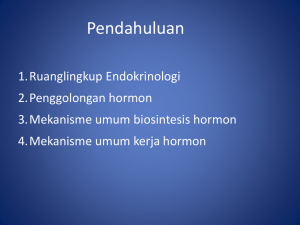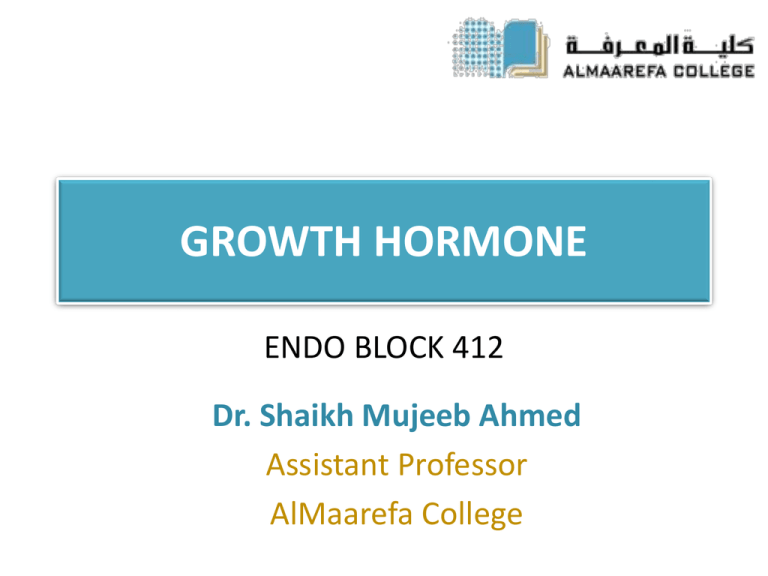
GROWTH HORMONE
ENDO BLOCK 412
Dr. Shaikh Mujeeb Ahmed
Assistant Professor
AlMaarefa College
Objectives
The student should be able to:
Identify the factors that affect growth beside the growth hormone.
Identify the hormones that affect growth beside the growth
hormone.
Describe the metabolic effect of growth hormone.
Identify the relationship between growth hormone and insulin-like
growth factors.
Explain the functions of the growth hormone.
Define the factors that influence the growth hormone secretion.
Describe the growth hormone abnormalities.
Describe the functions of melatonin hormone.
Explain the biological effect of melatonin hormone.
Endocrine Control of Growth
• Growth depends on growth hormone but is
influenced by other factors as well
– Genetic determination of an individual’s maximum
growth capacity
– An adequate diet
– Freedom from chronic disease and stressful
environmental conditions
– Normal levels of growth-influencing hormones
Hormones regulating growth
•
•
•
•
•
Thyroid Hormone
Insulin: Stimulates IGF-1
Prolactin: Stimulates IGF-1
Testosterone
Estrogen
Growth
• Other hormones besides growth hormone are essential
for normal growth
– Thyroid hormone
• Growth severely stunted in hypothyroid children
• Hypersecretion does not cause excessive growth
– Insulin
• Deficiency often blocks growth
• Hyperinsulinism often spurs excessive growth
– Androgens
• Play role in pubertal growth spurt, stimulate protein
synthesis in many organs
• Effects depend on presence of GH
– Estrogens
• Effects of estrogen on growth prior to bone maturation are
not well understood poorly
Growth Stages - Regulation
• Prenatal – Maternal factors, Fetal Insulin, &
IGF
• Growth in infancy – Genetic factors, GH
production, Thyroid hormone, IGF
• Adolescence- GH, Insulin, IGF & Sex hormone
surge
Growth hormone (GH)
• A peptide hormone (~200 amino acids)
• Also known as somatotropin:
– tropic hormone that affects somatic cells
Growth Hormone
GH Function: Direct Effect
• GH binds directly to its target cells:
– bones & muscles
• Stimulates growth
– Hypertrophy: increase in size/volume of cells
– Example: increase in bone thickness
• Stimulates cell reproduction
– Increased rate of mitosis
– Hyperplasia: increase in the number of cells, proliferation rate
– Example: increase in bone length
• Stimulates cell metabolism
– Increase protein synthesis
– Increase fat breakdown for energy
– Increase glycogen breakdown so that there is an increase in blood
glucose levels to fuel cell growth
Bone growth at the epiphyseal plate
GH function on metabolism
• Stimulates cell metabolism
• Increase protein synthesis
• amino acid transport through cell membrane
• catabolism of protein
• Increase fat breakdown for energy
• Carbohydrate metabolism
•
•
•
•
use of glucose for energy
glycogen deposition in the cell
blood glucose levels
insulin secretion
GH Function: Indirect Effect
• Most growth occurs through the indirect
method
• GH acts as a tropic hormone
• Signals the liver to produce Insulin-like Growth
Factors (IGF)
Growth Regulation: Neuroendocrine
pathway
Location
Hypothalamus
Hormone
Growth hormone release
hormone (GHRH)
Growth hormone inhibiting
hormone (GHIH) aka
somatostatin (SS)
Anterior Pituitary Growth hormone (GH)
Liver & other
Insulin-like growth factor
tissues
(IGF)
IGF-1: Insulin-like Growth Factor 1
• targets almost every cell in the body including
the muscle, cartilage, bone, and skin cells
• Stimulates hypertrophy and hyperplasia of the
cells
Growth Hormone Regulation
hypothalamus
growth hormone
releasing hormone
(GHRH)
growth hormone
inhibiting hormone
Somatostatin (GHIH)
anterior pituitary
growth hormone (GH)
GH half-life is
20 – 30 min
liver
Insulin-like growth
factor 1 (IGF-1)
Negative Feedback
• High levels of IGF-1
– Stimulates GHIH/SS
– decreased secretion of GH
• High levels of GH
– inhibits GHRH
GH Secretion
• Secreted in bursts (not
continuous)
• GH his released most
during sleep
– optimal at night time
– Changing sleeping
pattern affects GH
release
• GH production declines
with age
Increasing GH Production
•
•
•
•
Exercise regularly
8 hours of sleep
Protein-rich diet
Avoid Stress
GH Associated Disorders
• Dwarfism
• Gigantism
• Acromegaly
Dwarfism
• Deficiency in GH
• Short stature
– Adult 4'10" or shorter
• Proportional body
• Affects 1/10 000
• Occurs in children
– GH absent during child’s
development
• In one type of dwarfism (the African pygmy
and the Lévi-Lorain dwarf), the rate of growth
hormone secretion is normal or high, but
there is a hereditary inability to form
somatomedin C, which is a key step for the
promotion of growth by growth hormone.
Gigantism – Vertical Growth
• Excessive growth and
height
• Continuous secretion of GH
• Hyperglycemia or full
blown diabetes mellitus
• Open epiphyseal plate
– Affects bone growth length
• Occurs during childhood
World’s Tallest Man:
Robert Wadlow (1918-1940)
8 feet 11 inches and 439 pounds when he died
Tallest person alive
• Sultan Kosen
• born in Turkey
• 8 feet 1 inch
http://www.youtube.com/watch?v=ODFHC2XCtjU
http://www.youtube.com/watch?v=Rf-lcBzZwC4
Gigantism Cause
• Pituitary Adenoma
– Tumour formed by pituitary
gland
– Secretes excessive GH / IGF-1
– Non cancerous
• Average brain size
– Skull grows but brain size
stays the same, thus the
brain function is unchanged
Gigantism Problems
• Poor blood flow due to large body
• Increased muscle mass but weaker muscle
– Excess GH produces salt in muscle tissues
– Muscles swell with water
– Results in disproportional muscle growth
weaker muscles
Comparing Growths
Acromegaly – Lateral Growth
• Increased GH secretion in
adults
• Closed epiphyseal plate
– Bone lengthening stopped
• Bone width increases
• Slow progression
Acromegaly: Physical Effects
• Bone thickens
– Forehead expands
– Eyebrow ridges bulge outwards
– Cheekbones more prominent
– Mandible enlarges and pushes lower teeth
outwards and become widely space
Acromegaly: Physical Effects
• Soft tissue harden
– Deeper voice because larynx enlarges
– Bigger tongue and lips that affects breathing
– Cartilage in nose enlarges making nose broader
Acromegaly: Effect on Muscles
• Impaired Movements
– Enlargement of bones crushes
peroneal nerve in knee
– Nerve carries messages to move
foot and lower leg
– Nerve cannot send messages to
leg to trigger walking motion
• Also cause muscle numbness
• Leads to early death
Acromegaly: Heart Defects
• Heart tissue stiffen
– heart cannot contract and relax
– Ventricle harder to fill up
• Heart grows bigger in order to pump out
sufficient blood
Acromegaly: Lung Defect
• As bones grow, rib
cage expands
• Diaphragm is
stretched thin and
loses elasticity
• Breathing is reduced
The Pineal Gland
• The pineal gland is a small,
cone – shaped structure
located in the center of the
brain, diencephalon.
• The pineal gland is
composed of pinealocytes
& glial cells.
• Connects endocrine with
nervous system
Functions
• Secretion of the Hormone Melatonin
• Regulation of Endocrine Functions
• Conversion of Nervous System Signals to
Endocrine Signals
• Causes Feeling of Sleepiness
• Influences Sexual Development
• Precursor of melatonin is serotonin.
• Synthesis and secretion of melatonin is
affected by light exposure to the eyes.
Biological Effects of Melatonin
• Helps keep body’s circadian rhythms in synchrony with
light-dark cycle
• Effects on Reproductive Function
• Anti-gonadotropic
• Effects on Sleep and Activity
• Acts as antioxidant to remove free radicals
• Alterations in melanin pigment distribution
References
Human physiology, Lauralee Sherwood, seventh
edition.
Text book physiology by Guyton &Hall,11th edition.
Physiology by Berne and Levy, sixth edition.
38

